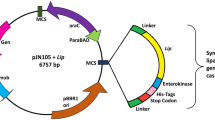Abstract
A putative dehalogenase, l-HADST, from the thermophile Sulfolobus tokodaii, was cloned and expressed in Escherichia coli. The recombinant enzyme catalyzes the stereospecific dehalogenation of l-2-haloacids with similar levels of activity as its homolog from mesophiles. l-HADST remains fully active after being incubated for 4 h at 70 °C and tolerates extreme pH conditions ranging from 4 to 10. Furthermore, it can be purified conveniently without the usage of any chromatography method. The high expression yield and easy purification procedure make the recombinant dehalogenase an excellent candidate for biotechnological applications.








Similar content being viewed by others
References
Bell, J. (1989). The polymerase chain-reaction. Immunology Today, 10, 351–355. doi:10.1016/0167-5699(89)90193-X.
White, T. J., Arnheim, N., & Erlich, H. A. (1989). The polymerase chain-reaction. Trends in Genetics, 5, 185–189. doi:10.1016/0168-9525(89)90073-5.
Chaudhry, G. R., & Chapalamadugu, S. (1991). Biodegradation of halogenated organic-compounds. Microbiological Reviews, 55, 59–79.
Fetzner, S., & Lingens, F. (1994). Bacterial dehalogenases-biochemistry, genetics, and biotechnological applications. Microbiological Reviews, 58, 641–685.
van Pee, K. H., & Unversucht, S. (2003). Biological dehalogenation and halogenation reactions. Chemosphere, 52, 299–312. doi:10.1016/S0045-6535(03)00204-2.
Baxter-Plant, V. S., Mikheenko, I. P., Robson, M., Harrad, S. J., & Macaskie, L. E. (2004). Dehalogenation of chlorinated aromatic compounds using a hybrid bioinorganic catalyst on cells of desulfiovibrio desulfuricans. Biotechnology Letters, 26, 1885–1890. doi:10.1007/s10529-004-6039-x.
Bayless, W., & Andrews, R. C. (2008). Biodegradation of six haloacetic acids in drinking water. Journal of Water and Health, 6, 15–22. doi:10.2166/wh.2007.002.
Bhatt, P., Kumar, M. S., Mudliar, S., & Chakrabarti, T. (2007). Biodegradation of chlorinated compounds—A review. Critical Reviews in Environmental Science and Technology, 37, 165–198. doi:10.1080/10643380600776130.
Erable, B., Goubet, I., Lamare, S., Legoy, M. D., & Maugard, T. (2004). Haloalkane hydrolysis by rhodococcus erythropolis cells: Comparison of conventional aqueous phase dehalogenation and nonconventional gas phase dehalogenation. Biotechnology and Bioengineering, 86, 47–54. doi:10.1002/bit.20035.
Erable, B., Goubet, I., Lamare, S., Legoy, M. D., & Maugard, T. (2006). Bioremediation of halogenated compounds: Comparison of dehalogenating bacteria and improvement of catalyst stability. Chemosphere, 65, 1146–1152. doi:10.1016/j.chemosphere.2006.04.007.
Hardman, D. J. (1991). Biotransformation of halogenated compounds. Critical Reviews in Biotechnology, 11, 1–40. doi:10.3109/07388559109069182.
Hiraishi, A. (2008). Biodiversity of dehalorespiring bacteria with special emphasis on polychlorinated biphenyl/dioxin dechlorinators. Microbes and Environments, 23, 1–12. doi:10.1264/jsme2.23.1.
McRae, B. M., LaPara, T. M., & Hozalski, R. M. (2004). Biodegradation of haloacetic acids by bacterial enrichment cultures. Chemosphere, 55, 915–925. doi:10.1016/j.chemosphere.2003.11.048.
Neilson, A. H. (1990). The biodegradation of halogenated organic-compounds—a review. The Journal of Applied Bacteriology, 69, 445–470.
Kawarabayasi, Y., Hino, Y., Horikawa, H., Jin-no, K., Takahashi, M., Sekine, M., et al. (2001). Complete genome sequence of an aerobic thermoacidophilic crenarchaeon, Sulfolobus tokodaii strain7. DNA Research, 8, 123–140. doi:10.1093/dnares/8.4.123.
Kurihara, T., Esaki, N., & Soda, K. (2000). Bacterial 2-haloacid dehalogenases: Structures and reaction mechanisms. Journal of Molecular Catalysis. B, Enzymatic, 10, 57–65. doi:10.1016/S1381-1177(00)00108-9.
Liu, J. Q., Kurihara, T., Hasan, A., Nardidei, V., Koshikawa, H., Esaki, N., et al. (1994). Purification and characterization of thermostable and nonthermostable 2-haloacid dehalogenases with different stereospecificities from Pseudomonas sp strain YL. Applied and Environmental Microbiology, 60, 2389–2393.
Baker-Austin, C., & Dopson, M. (2007). Life in acid: Ph homelostasis in acidophiles. Trends in Microbiology, 15, 165–171. doi:10.1016/j.tim.2007.02.005.
Hisano, T., Hata, Y., Fujii, T., Liu, J. Q., Kurihara, T., Esaki, N., et al. (1996). Crystal structure of l-2-haloacid dehalogenase from Pseudomonas sp YL—an alpha/beta hydrolase structure that is different from the alpha/beta hydrolase fold. The Journal of Biological Chemistry, 271, 20322–20330. doi:10.1074/jbc.271.34.20322.
Newman, J., Peat, T. S., Richard, R., Kan, L., Swanson, P. E., Affholter, J. A., et al. (1999). Haloalkane dehalogenases: Structure of a rhodococcus enzyme. Biochemistry, 38, 16105–16114. doi:10.1021/bi9913855.
Ridder, I. S., Rozeboom, H. J., Kalk, K. H., Janssen, D. B., & Dijkstra, B. W. (1997). Three-dimensional structure of l-2-haloacid dehalogenase from Xanthobacter autotrophicus gj10 complexed with the substrate-analogue formate. The Journal of Biological Chemistry, 272, 33015–33022. doi:10.1074/jbc.272.52.33015.
Kurihara, T., Liu, J. Q., Nardidei, V., Koshikawa, H., Esaki, N., & Soda, K. (1995). Comprehensive site-directed mutagenesis of l-2-haloacid dehalogenase to probe catalytic amino acid residues. Journal of Biochemistry, 117, 1317–1322.
Liu, J. Q., Kurihara, T., Miyagi, M., Esaki, N., & Soda, K. (1995). Reaction-mechanism of l-2-haloacid dehalogenase of Pseudomonas sp. Yl—identification of asp10 as the active site nucleophile by o18 incorporation experiments. The Journal of Biological Chemistry, 270, 18309–18312. doi:10.1074/jbc.270.31.18309.
Rye, C. A., Isupov, M. N., Lebedev, A. A., & Littlechild, J. A. (2007). An order-disorder twin crystal of l-2-haloacid dehalogenase from Sulfolobus tokodaii. Acta Crystallographica. Section D, Biological Crystallography, 63, 926–930. doi:10.1107/S0907444907026315.
Meller, J., & Elber, R. (2001). Linear programming optimization and a double statistical filter for protein threading protocols. Proteins-Structure Function and Genetics, 45, 241–261. doi:10.1002/prot.1145.
Teodorescu, O., Galor, T., Pillardy, J., & Elber, R. (2004). Enriching the sequence substitution matrix by structural information. Proteins-Structure Function and Bioinformatics, 54, 41–48. doi:10.1002/prot.10474.
Tobi, D., & Elber, R. (2000). Distance-dependent, pair potential for protein folding: Results from linear optimization. Proteins-Structure Function and Genetics, 41, 40–46. doi:10.1002/1097-0134(20001001)41:1<40::AID-PROT70>3.0.CO;2-U.
Li, Y. F., Hata, Y., Fujii, T., Hisano, T., Nishihara, M., & Kurihara, T. (1998). Crystal structures of reaction intermediates of l-2-haloacid dehalogenase and implications for the reaction mechanism. The Journal of Biological Chemistry, 273, 15035–15044. doi:10.1074/jbc.273.24.15035.
Ridder, I. S., Rozeboom, H. J., Kalk, K. H., & Dijkstra, B. W. (1999). Crystal structures of intermediates in the dehalogenation of haloalkanoates by l-2-haloacid dehalogenase. The Journal of Biological Chemistry, 274, 30672–30678. doi:10.1074/jbc.274.43.30672.
Kumar, S., & Nussinov, R. (2001). How do thermophilic proteins deal with heat. Cellular and Molecular Life Sciences, 58, 1216–1233. doi:10.1007/PL00000935.
Acknowledgment
This work was supported by the National Institute of Environmental Health Sciences (NIH, grant P42 ES07380). We acknowledge the use of the circular dichroism spectrometer at the Protein Core facility housed in the Department of Molecular and Cellular Biochemistry, University of Kentucky and directed by Dr. David Rodgers.
Author information
Authors and Affiliations
Corresponding author
Rights and permissions
About this article
Cite this article
Bachas-Daunert, P.G., Law, S.A. & Wei, Y. Characterization of a Recombinant Thermostable Dehalogenase Isolated from the Hot Spring Thermophile Sulfolobus tokodaii . Appl Biochem Biotechnol 159, 382–393 (2009). https://doi.org/10.1007/s12010-009-8589-9
Received:
Accepted:
Published:
Issue Date:
DOI: https://doi.org/10.1007/s12010-009-8589-9




